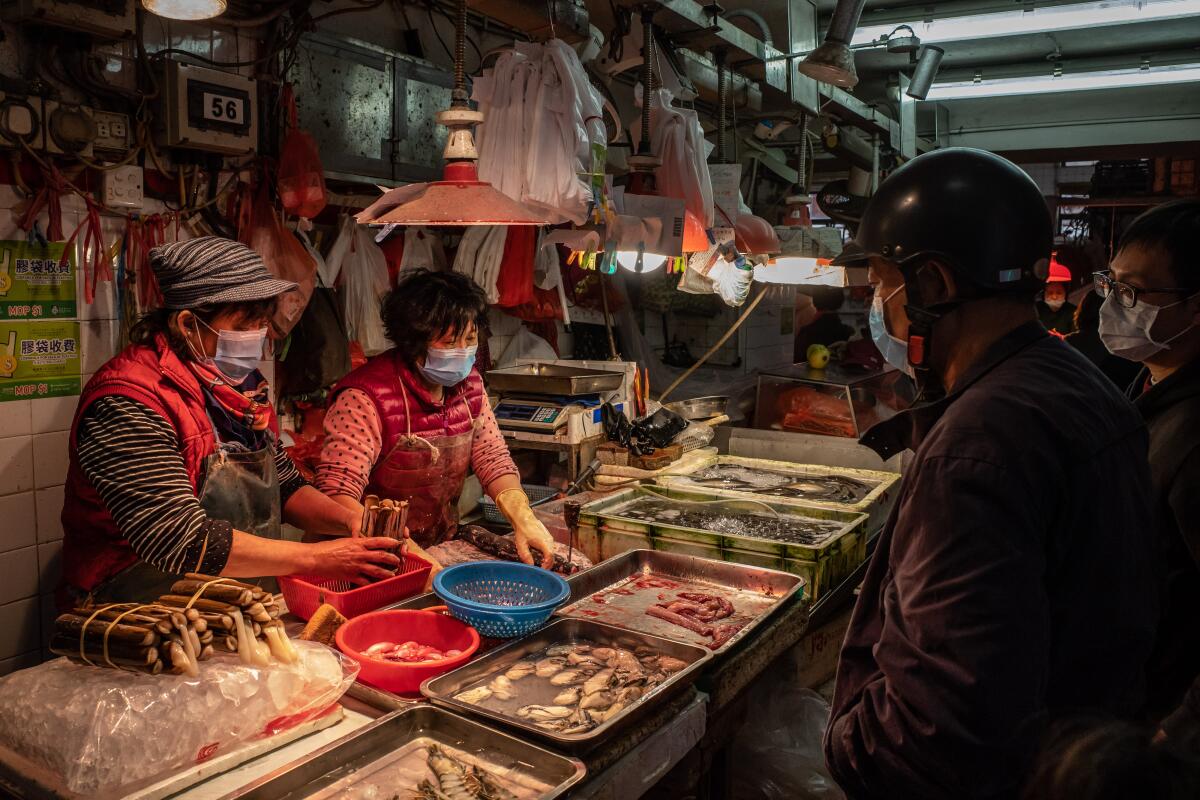Commentary: No, China’s fresh food markets did not cause coronavirus

As some media outlets cover the coronavirus, journalists are mixing up wet markets and wildlife markets. But most wet markets are not wildlife markets, and confusing the two is dangerous.
“Wet” markets are what China calls its fresh food markets, the kind you see all over the developing world and in many parts of Europe, where small stalls sell fresh vegetables and butchers sell meat, primarily pork. They are the daily market for tens of millions of Chinese who prefer to talk to the people who sell them produce, meat, seafood and tofu, and in small cities, are often the only outlet for small-scale farmers who can’t meet the supplier requirements for supermarkets. (Still, it’s important to differentiate: Most wet markets, especially in big cities, may look like farmers markets but are buying from the same wholesale suppliers as supermarkets.)
What happens when you try to make your hand sanitizer with stuff you got from BevMo to ward off the coronavirus? Just wash your hands instead.
They are a cornerstone of China’s food distribution system and have benefits for society both tangible and intangible, from improved nutrition for children to stronger interpersonal relationships. So-called for their open-air origins, where the ground was hosed down throughout the day, they are the traditional backbone to China’s food supply system.
In an aesthetic sense, they are an antidote to the sterile, plastic-wrapped world of the supermarkets that have tried unsuccessfully to replace them. In the early 2000s, China implemented a policy called nong gai chao or replacing wet markets with supermarkets, in a bid to upgrade cities and modernize wet markets. After a couple of years, and a boom in the number of supermarkets from foreign companies like Carrefour and local ones like Hualian, customers stuck by their wet markets for most fresh food and turned to supermarkets for supplemental shopping and dry goods.
Wet markets are a reserve of diversity in an age of consolidation and streamlining and a hedge against the supermarketization of China’s food. Far from being replaced by supermarkets, wet markets have made improvements in sanitation and hygiene and are still thriving. In Shanghai alone, there were nearly 1,000 as of 2019. After a several-month renovation, my daily wet market in Shanghai’s former French Concession reopened last month with terrazzo floors and windowed doors. It is not the norm; it is a model.
On a social level, wet markets are important as a way to pass down cultural food knowledge. Stallholders often make recommendations for which vegetables traditionally go together and how to cook them. They discuss which vegetables are in season, coming into season or going out of season. They foster long-term relationships between customers and stallholders, creating a personal bond hard to find in a supermarket.
And their business model often means lower prices. Although both supermarkets and wet markets in China often buy from the same wholesale suppliers, supermarkets generally bring in their vegetables the evening before they go on sale to clean, weigh and package; on the other hand, wet market vendors, who are individual small business owners, start their day at 4 a.m. with a trip to the wholesale market before a 6 a.m. start at the wet market and spend their day pruning and misting vegetables as they sell. The result is that their vegetables and produce look fresher, and their reduced overhead (supermarkets incur high labor, rent and stocking fees) translates into lower prices.
Here are eight tips for cooking clean in your own kitchen to prevent germs from spreading and to make the cooking process more pleasurable.
On a broader level, having wet markets available is good for the health of neighborhood children, particularly of low-income families. According to a 2012 study based on China Health and Nutrition Survey data, the density of wet markets in China positively predicted children’s nutritional intake. Basically, the study found, when families have access to wet markets, children eat less manufactured supermarket food, which has higher amounts of added salt and sugar. The markets also provide one of a limited number of avenues for rural migrants to make a relatively high income and move up the social ladder.
The issue, according to numerous op-ed articles, is when wildlife is introduced into this system. Rightly, critics note that bringing stressed animals of different species, who are all shedding different diseases, into close proximity and without any supervision, is, let’s say, not good for hygiene. At worst, it may provide the breeding ground for COVID-19, SARS and the avian flu.
The attention-grabbing koala and wolf cub price list touted in Western media is likely exaggerated, but the general point remains true: China has a taste for exotic meat. In my 15 years in China, I’ve been offered camel hump at a major Chinese chain, muntjac at a secret wild game restaurant in Pudong and legal peacock in Yunnan, have watched a bamboo rat butchered and cooked by a popular online chef and seen a crocodile, mouth tied shut, hidden under a bench at a downtown Shanghai seafood market. Snake is more than a delicacy; by one count, Shanghai has more than 800 shops serving water snakes, king snakes and more.
Yet a taste for the exotic is not the problem. Where I’m from, in South Florida, people now patrol backyards in search of iguanas for the dinner table; restaurants serve BBQ alligator ribs; and it’s possible to order overnight delivery of muskrat, bobcat and rattlesnake on the internet.
Beyond meat that tastes good, at least to someone, an interest in exotic meats is rooted in homology beliefs extending back to “The Yellow Emperor’s Inner Classics,” which codified the medicinal philosophy more than 2,000 years ago; the idea that eating exotics confers wealth and status on the buyer; and the belief that certain wild animal parts have therapeutic effects (pangolin meat relieving rheumatism, for example). Weak legal controls push the sale of even the less exotic meats such as venison and pheasant into an unregulated and unsupervised gray area.
According to the United Nations, gray areas in the wildlife trade, which mix legal and illegal species, as the Wuhan market at the probable start of the coronavirus outbreak did, can be more dangerous than black markets. In black markets, everyone knows it’s illegal. In gray markets, law-abiding consumers can confuse availability for legality.
It’s in that gray area that disease breeds, animal cruelty can thrive and wild animals are smuggled. An open and frank discussion, free from the stigma of eating exotic meats, would go a long way toward the eventual necessity of a regulated system from farm to abattoir, to bring these meats out of the gray market and into the 21st century. Reform and streamlining of the control and management of wet markets, which often mix public and private ownership to chaotic effect, could help. In the absence of unified management, hygiene and regulation can fall through the cracks, leading to illegal wildlife trading.
But this is a wildlife regulation problem, not a wet market problem. Not that long ago, chickens in wet markets were sold live, killed on the spot. Avian flu and the subsequent wholesale elimination of live chickens from wet markets is proof that the country has the regulatory power and ability to execute urgent health policy when it needs to. Exotic meat does not need to be regulated out of existence, as a bill passed in China’s legislature on Feb. 24 promised, but needs a more nuanced and comprehensive approach. A blanket ban will only push it underground. Education, regulation, a supervised farm network and explicitly legal channels for consumers are all needed to counter the existing gray market.
China’s wet markets are more vital and in need now than ever, for its eaters, its children and the fraying social fabric of a country grappling with the world’s largest wave of urbanization.
If the trend of supermarkets in the West takes root in China, they will begin selling more processed foods than produce, high in calories, salt and sugar. Wet markets sell ingredients. This is especially important as a second wave of modern supermarkets is now cropping up across China. Alibaba has launched a successful chain of online/offline hybrid supermarkets under the Hema brand, while JD.com has done the same with its 7Fresh brand.
Right now, China’s supermarket industry remains highly fragmented and regional, with no major national brand dominating like those in the U.S. and the United Kingdom. But eventually there will be market consolidation, and with that a further streamlining of China’s food supply: produce optimized for transport ability, not flavor, a higher proportion of high-salt and high-fat prepared food, a diminished range of seasonal and delicate produce and the further loss of food knowledge transmitted where people buy their food.
Christopher St. Cavish is a writer living in Shanghai.
More to Read
Eat your way across L.A.
Get our weekly Tasting Notes newsletter for reviews, news and more.
You may occasionally receive promotional content from the Los Angeles Times.







